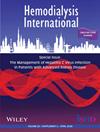Prosthesis use and the change in activities of daily living following below-knee amputation in patients undergoing hemodialysis
Abstract
Introduction
Patients undergoing hemodialysis are at an increased risk of peripheral arterial disease, amputation of lower extremities, and decline of activities of daily living. Although a prosthesis is used to support activities of daily living, no previous study reported the association of prosthesis use with the change in activities of daily living following leg amputation in hemodialysis patients. The purpose of this study was to compare the changes in activities of daily living following amputation between those who created a prosthesis and those who did not.
Methods
This study was a single-center, retrospective observational study. We screened medical records for hemodialysis patients who underwent below-knee amputation (BKA) and activities of daily living were examined two times with the functional independence measure (FIM) before BKA and at discharge. They were divided into two groups according to the creation of a prosthesis.
Findings
We identified 28 eligible patients, among whom 12 patients used a prosthesis (prosthesis group), whereas 16 patients did not (non-prosthesis group). The FIM score was significantly decreased following BKA in the non-prosthesis group, whereas it was not significantly changed in the prosthesis group. The change in FIM score was significantly different between the two groups, and the difference remained significant after considering potential confounders.
Discussion
The results of this study showed that use versus nonuse of a prosthesis was an independent factor associated with changes in activities of daily living in hemodialysis patients following BKA, supporting the important role of a prosthesis in maintaining activities of daily living in hemodialysis patients who need BKA.

 求助内容:
求助内容: 应助结果提醒方式:
应助结果提醒方式:


